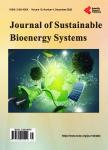Influence of Agitation and Aeration on Single Cell Oil Production by Rhodotorula glutinis from Glycerol
作者机构:Department of Chemical EngineeringEngineering College of LorenaUniversity of Sao PauloLorena/SPBrazil
出 版 物:《Journal of Sustainable Bioenergy Systems》 (可持续生物质能源系统(英文))
年 卷 期:2019年第9卷第2期
页 面:29-43页
学科分类:1002[医学-临床医学] 100214[医学-肿瘤学] 10[医学]
基 金:the financial support from FAPESP(Fundacao de Amparo a Pesquisa do Estado de Sao Paulo—Process Number 2016/06683-0) the CNPq(Conselho Nacional de Desenvolvimento Cientifico e Tecnologico-Process Number 455260/2014-1) financed in part by the Coordenacao de Aperfeicoamento de Pessoal de Nivel Superior—Brasil(CAPES)—Finance Code 001
主 题:Single-Cell Oil Rhodotorula glutinis Aeration Glycerol Oleaginous Yeast
摘 要:In the present study, the yeast Rhodotorula glutinis has been assessed with the aim of producing microbial lipids from glycerol under different aeration conditions. For such a purpose, experiments were carried out in shake flasks, under different conditions of agitation (150 to 250 rpm) and aeration (2.5 to 5.0 of flask volume-to-medium volume ratio). Furthermore, their influence on fermentative parameters (lipid and cell concentration, biomass yield;lipid yield;and lipid volumetric productivity) has been investigated using a 22 full factorial design. The statistical analysis has revealed a strong influence of both variables on substrate consumption, lipid accumulation, cell growth and lipid productivity. As a whole, results suggest that higher aeration levels provide greater cell and lipid concentrations, and lipid volumetric productivity. The best results (4.5 g/L of lipids and QP = 0.95 g/L⋅day) were achieved at the highest aeration (5.0 flask volume-to-medium volume ratio) and agitation (250 rpm) levels. Their fatty acid profile showed that oleic acid was produced in greater quantity (53.5%), followed by linoleic acid (18.7%), palmitic acid (6.8%) and stearic acid (9.9%). The microbial oil presented viscosity of 39.3 cP at 50°C and free fatty acid content of 1.93% ± 0.08%. These are significant results and contribute to establishing operational conditions that maximize single-cell oil production from glycerol by Rhodotorula glutinis, i.e. an alternative source as renewable raw material for lipid-based biorefineries.



